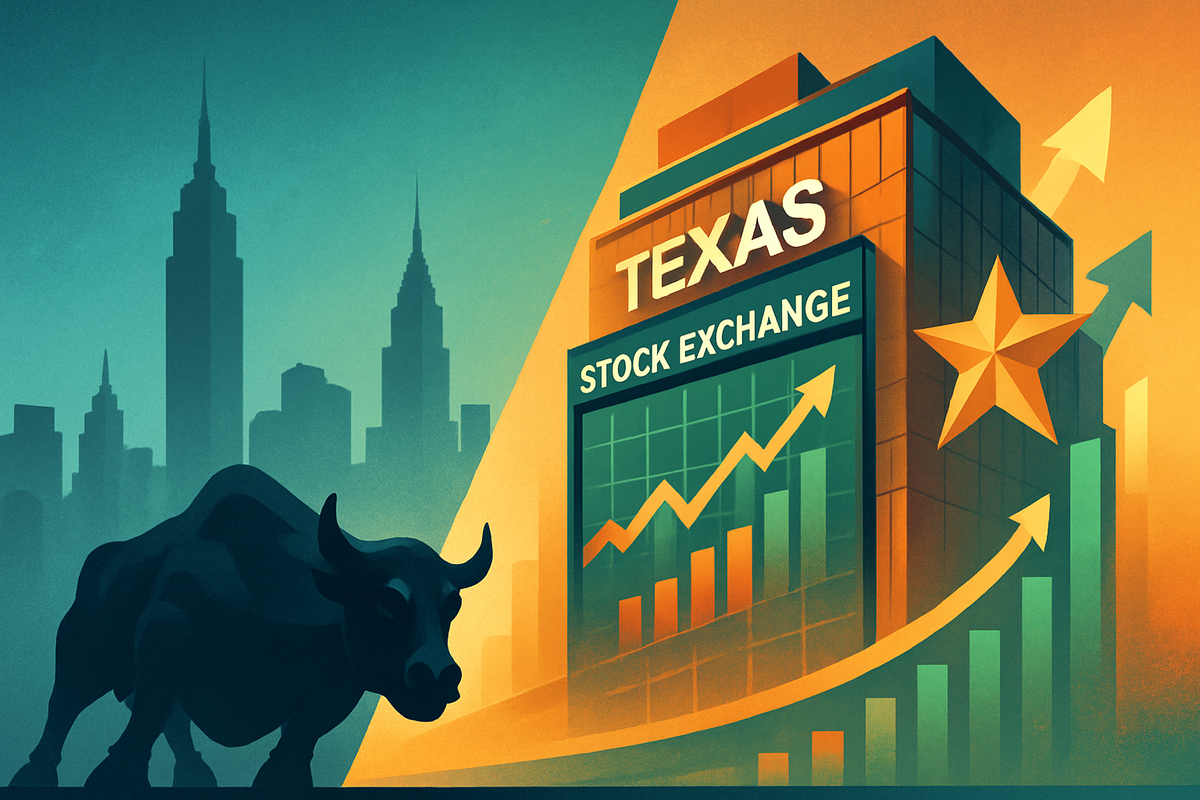
The U.S. Securities and Exchange Commission (SEC) delivered a landmark decision on September 30, 2025, formally approving the Texas Stock Exchange (TXSE). This pivotal move greenlights the creation of a new national securities exchange based in Dallas, poised to become the first fully integrated national exchange to receive SEC endorsement in decades. The TXSE’s approval signals a significant shift in the American financial landscape, directly challenging the long-held duopoly of the New York Stock Exchange (NYSE) and Nasdaq (NASDAQ).
This audacious venture aims to revitalize competition in public markets, offering a fresh alternative for companies seeking to go public and trade their shares. With operations expected to commence by early 2026, the TXSE promises a pro-business environment, potentially reshaping how companies access capital and how investors engage with public markets. The immediate implications are profound, hinting at a potential redistribution of financial power and an acceleration of Texas's emergence as a formidable financial hub.
A New Frontier in American Finance: The Genesis and Goals of the Texas Stock Exchange
The formal approval of the Texas Stock Exchange (TXSE) by the U.S. Securities and Exchange Commission (SEC) on September 30, 2025, marks a monumental moment in the history of American financial markets. This decision, which has already occurred by the current date of October 6, 2025, sets the stage for a new era of competition, promising to disrupt the established order dominated by New York-based exchanges. The TXSE, headquartered in Dallas, is not just another trading venue; it represents a philosophical challenge to the status quo, advocating for what it terms "free-market principles" and a more issuer-friendly environment.
The journey to SEC approval has been years in the making, driven by a consortium of financial heavyweights and Texas-based business leaders. The TXSE's proponents have consistently argued for the necessity of a new exchange to address the decades-long decline in the number of U.S. public companies. Their vision includes streamlining the listing process, reducing compliance burdens, and offering more flexible listing requirements, particularly for small and medium-sized enterprises (SMEs) that often find the costs and complexities of existing exchanges prohibitive. Backed by substantial investments from major financial institutions, including BlackRock (NYSE: BLK) and Citadel Securities, the TXSE is one of the most well-capitalized attempts at a new national exchange in recent memory, indicating a serious intent to compete.
Initial market reactions have been a mix of anticipation and strategic adaptation. The announcement has solidified Dallas's burgeoning reputation as a significant financial hub, a development celebrated by Texas Governor Greg Abbott, who declared, "Texas is swiftly becoming America's financial hub." This sentiment is underscored by the proactive responses from incumbent exchanges. The New York Stock Exchange (NYSE) announced plans to reincorporate its Chicago electronic exchange and move it to Dallas, rebranding it NYSE Texas, which notably launched in March 2025, ahead of TXSE's trading start. Nasdaq (NASDAQ: NDAQ) also declared its intention to open a regional headquarters in Dallas, signaling that the established players are not taking the challenge lightly and are prepared to expand their footprint to compete on new battlegrounds. The TXSE itself has already completed its proprietary order matching engine and exchange platform, utilizing advanced hardware and software designed for low-latency performance, flexibility, and scalability, positioning itself for a technological edge upon its planned launch of trading stocks and exchange-traded products (ETPs) by early 2026.
Companies Poised to Win or Lose in the New Exchange Landscape
The advent of the Texas Stock Exchange (TXSE) is set to send ripples through the corporate world, creating both significant opportunities and potential challenges for a diverse range of companies. At the forefront of potential beneficiaries are small and medium-sized enterprises (SMEs), particularly those in Texas and the broader Sun Belt region, that have historically found the costs and stringent requirements of listing on New York exchanges prohibitive. The TXSE's stated goal of offering more accessible and less burdensome listing requirements could unlock a new avenue for these companies to go public, raise capital, and expand. This could include tech startups, energy firms, and manufacturing companies looking for a listing venue aligned with a pro-business regulatory environment. Companies like those in the burgeoning Texas tech scene, such as Dell Technologies (NYSE: DELL) or even smaller, privately held innovators, might find the TXSE an attractive alternative for future listings or secondary offerings, potentially leading to increased liquidity and growth.
Conversely, the immediate "losers" might not be individual companies but rather the entrenched dominance of the New York Stock Exchange (NYSE) and Nasdaq (NASDAQ). While these exchanges are adapting by establishing presences in Texas, a successful TXSE could erode their market share in new listings and trading volume over time. Companies that have long relied on the prestige and deep liquidity of New York exchanges might face a strategic decision regarding where to list, especially if the TXSE proves to offer competitive advantages in terms of cost, regulatory environment, or access to specific investor bases. Furthermore, companies providing ancillary services to the financial markets, such as financial data providers, trading technology firms, and legal and compliance consultants, will need to adapt their offerings to cater to the new exchange's ecosystem.
Beyond the exchanges themselves, the event could impact a broader spectrum of public companies. Those with a strong operational presence or headquarters in Texas, or those that align with the TXSE's free-market philosophy, might find it advantageous to consider a dual listing or even a primary listing on the new exchange. This could enhance their visibility within a growing financial hub and potentially attract a new pool of regional investors. For instance, major corporations with significant Texas operations, such as ExxonMobil (NYSE: XOM) or AT&T (NYSE: T), while unlikely to abandon their current listings, might observe the TXSE's development closely for strategic implications. Moreover, investment banks and brokerage firms will need to expand their capabilities to facilitate trading and listings on the TXSE, potentially leading to new revenue streams for those that adapt quickly and effectively.
Reshaping the Financial Landscape: Wider Significance and Broader Implications
The SEC's approval of the Texas Stock Exchange (TXSE) transcends a mere regulatory nod; it represents a significant inflection point in the evolution of U.S. financial markets, poised to reshape industry dynamics and challenge long-held geographical concentrations of financial power. This event fits squarely into a broader trend of decentralization and the emergence of new financial hubs outside traditional centers like New York and Chicago. States like Texas, Florida, and even parts of the Mountain West have seen an influx of businesses and capital, driven by favorable tax policies, lower costs of living, and a pro-business regulatory environment. The TXSE is a natural culmination of this migration, formalizing Texas's ambition to become a premier destination for corporate headquarters and financial operations.
The potential ripple effects on competitors and partners are substantial. For the New York Stock Exchange (NYSE) and Nasdaq (NASDAQ), the TXSE is not just a new entrant but a formidable challenger backed by significant capital and a distinct market philosophy. While both incumbents have moved to establish a presence in Texas, the long-term competitive landscape will depend on how effectively the TXSE can attract listings and liquidity. This could lead to an intensified battle for corporate listings, potentially driving down listing fees and prompting innovation in exchange services across the board. Partners, such as clearing houses, market makers, and technology vendors, will need to integrate with the TXSE, creating new business opportunities but also requiring adaptation to a potentially different operational framework and rulebook.
From a regulatory and policy standpoint, the TXSE's approval could spark a broader conversation about market structure, competition, and the role of regional exchanges. Policymakers may scrutinize existing listing requirements and regulatory burdens on public companies, particularly if the TXSE successfully demonstrates a more efficient and less costly path to public markets without compromising investor protection. Historically, the U.S. has seen periods of significant competition among exchanges, with regional exchanges playing a vital role before consolidation led to the current duopoly. The TXSE’s emergence harks back to these earlier eras, potentially signaling a new cycle of diversification in market infrastructure. Its emphasis on "free-market principles" could also influence future legislative debates regarding financial regulation and corporate governance, particularly in a political climate increasingly sensitive to economic decentralization.
The Road Ahead: Short-Term Possibilities and Long-Term Scenarios
The approval of the Texas Stock Exchange (TXSE) by the SEC on September 30, 2025, has set the stage for a dynamic period of transition and innovation in the U.S. financial markets. In the short term, the immediate focus will be on the TXSE's operational launch, expected in early 2026. This includes the successful rollout of trading services for stocks and exchange-traded products (ETPs) in Q1 2026, followed by the introduction of indices and additional ETPs in Q2, and crucially, the commencement of corporate listings in the latter half of the year. The initial success will hinge on its ability to attract sufficient trading volume and, more importantly, secure its first significant corporate listings. Market participants will be closely watching for early adopters among companies, particularly those in Texas or the broader Sun Belt, who might see strategic advantages in being among the first to list on a new, regionally focused exchange.
Looking further ahead, the long-term possibilities are vast and could fundamentally alter the U.S. financial landscape. One potential strategic pivot for companies might involve considering dual listings, maintaining a presence on a New York exchange while also listing on the TXSE to tap into different investor bases or demonstrate alignment with the Texas business ethos. For companies contemplating an initial public offering (IPO), the TXSE offers a genuine alternative, potentially leading to a more competitive market for listing services. This could force existing exchanges to re-evaluate their fee structures and value propositions. New market opportunities may emerge for financial technology (fintech) companies specializing in exchange integration, data analytics, and compliance solutions tailored to the TXSE's unique platform and regulatory framework.
Several scenarios could unfold. In an optimistic scenario, the TXSE gains significant traction, attracting a steady stream of new listings and substantial trading volume, establishing itself as a viable third national exchange. This would lead to enhanced competition, potentially benefiting issuers through lower costs and greater flexibility, and investors through more diverse investment opportunities. In a more moderate scenario, the TXSE carves out a niche, perhaps specializing in specific industries like energy or technology, or catering primarily to regional companies, without directly challenging the overall dominance of NYSE and Nasdaq. A less favorable outcome, though less likely given its strong backing, could see the TXSE struggle to gain sufficient liquidity or listings, ultimately becoming a minor player. However, the proactive response from NYSE and Nasdaq, by establishing their own Texas presences, suggests they view the TXSE as a serious threat, indicating a high probability of a competitive and transformative future.
A New Era for American Finance: Key Takeaways and Future Watchpoints
The SEC's approval of the Texas Stock Exchange (TXSE) on September 30, 2025, represents more than just the birth of a new trading venue; it signifies a pivotal moment for American financial markets, ushering in an era of renewed competition and potential decentralization. The key takeaway is the challenge to the long-standing duopoly of the New York Stock Exchange and Nasdaq, promising to offer a fresh alternative for companies seeking to go public and trade their shares. This move underscores the growing economic influence of Texas and the broader Sun Belt, positioning Dallas as a significant financial hub and potentially reshaping the geographical distribution of financial power in the U.S. The TXSE's emphasis on reduced burdens for issuers and a pro-business environment could democratize access to public capital markets for a wider array of companies, particularly SMEs.
Moving forward, the market will closely assess the TXSE's operational launch in early 2026. Its success will be measured by its ability to attract initial listings, generate sufficient trading volume, and demonstrate a competitive advantage in terms of cost, efficiency, and issuer-friendliness. The responses from incumbent exchanges, already seen in NYSE's establishment of NYSE Texas and Nasdaq's regional expansion, indicate that competition will be fierce. This rivalry is likely to spur innovation across the industry, potentially leading to better services and lower costs for all market participants.
Investors should watch for several key indicators in the coming months. First, monitor the TXSE's initial listing announcements: which companies choose to list, and what industries do they represent? Second, observe trading volumes and liquidity on the new exchange to gauge its viability and attractiveness to institutional and retail investors. Third, pay attention to any shifts in listing requirements or fee structures from NYSE and Nasdaq as they respond to the new competitive pressure. Finally, keep an eye on regulatory developments, as the emergence of a new national exchange could prompt broader discussions about market structure and competition within the SEC and Congress. The TXSE's journey is just beginning, but its approval has undeniably set a new course for the future of American finance.
This content is intended for informational purposes only and is not financial advice





